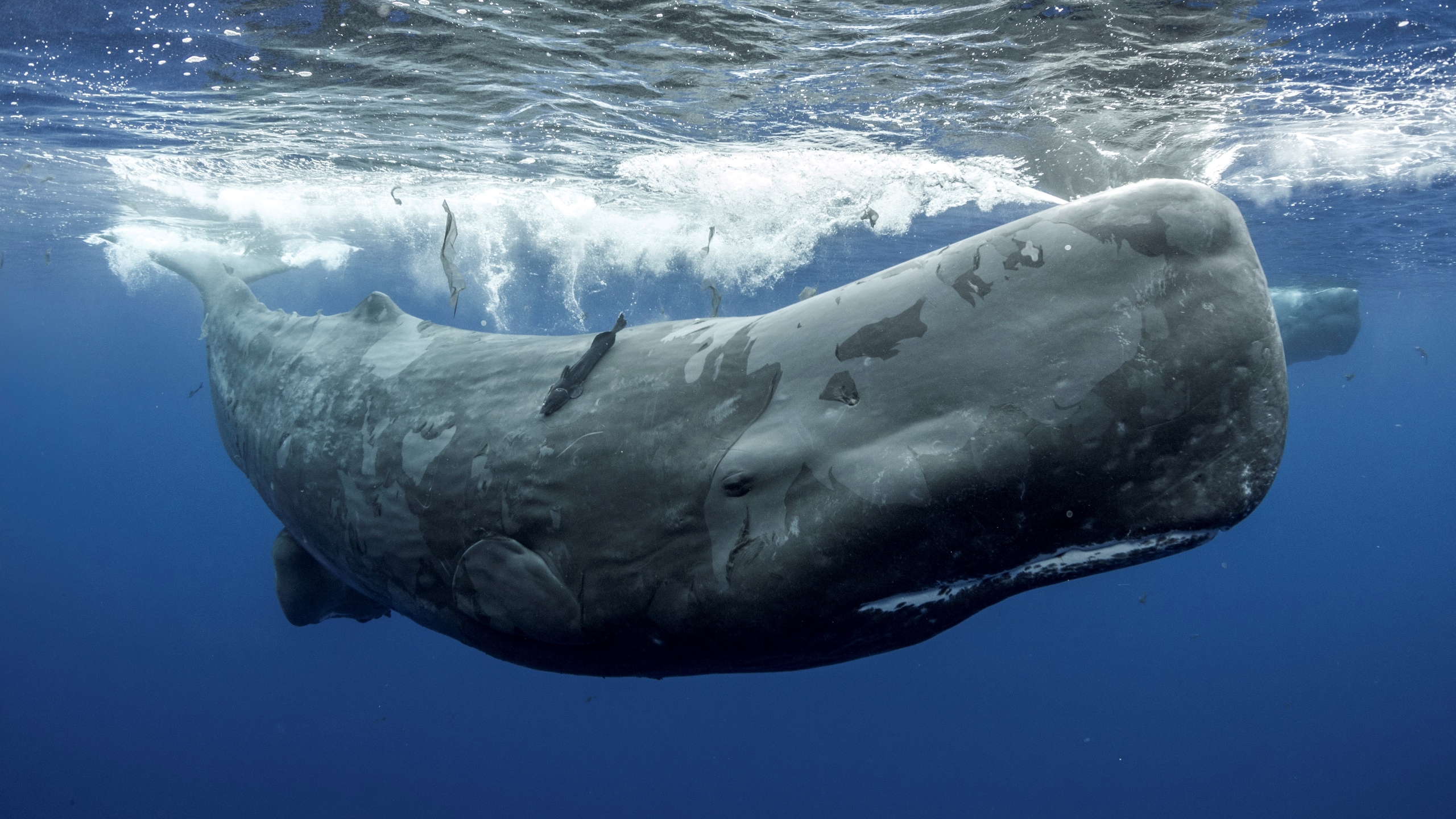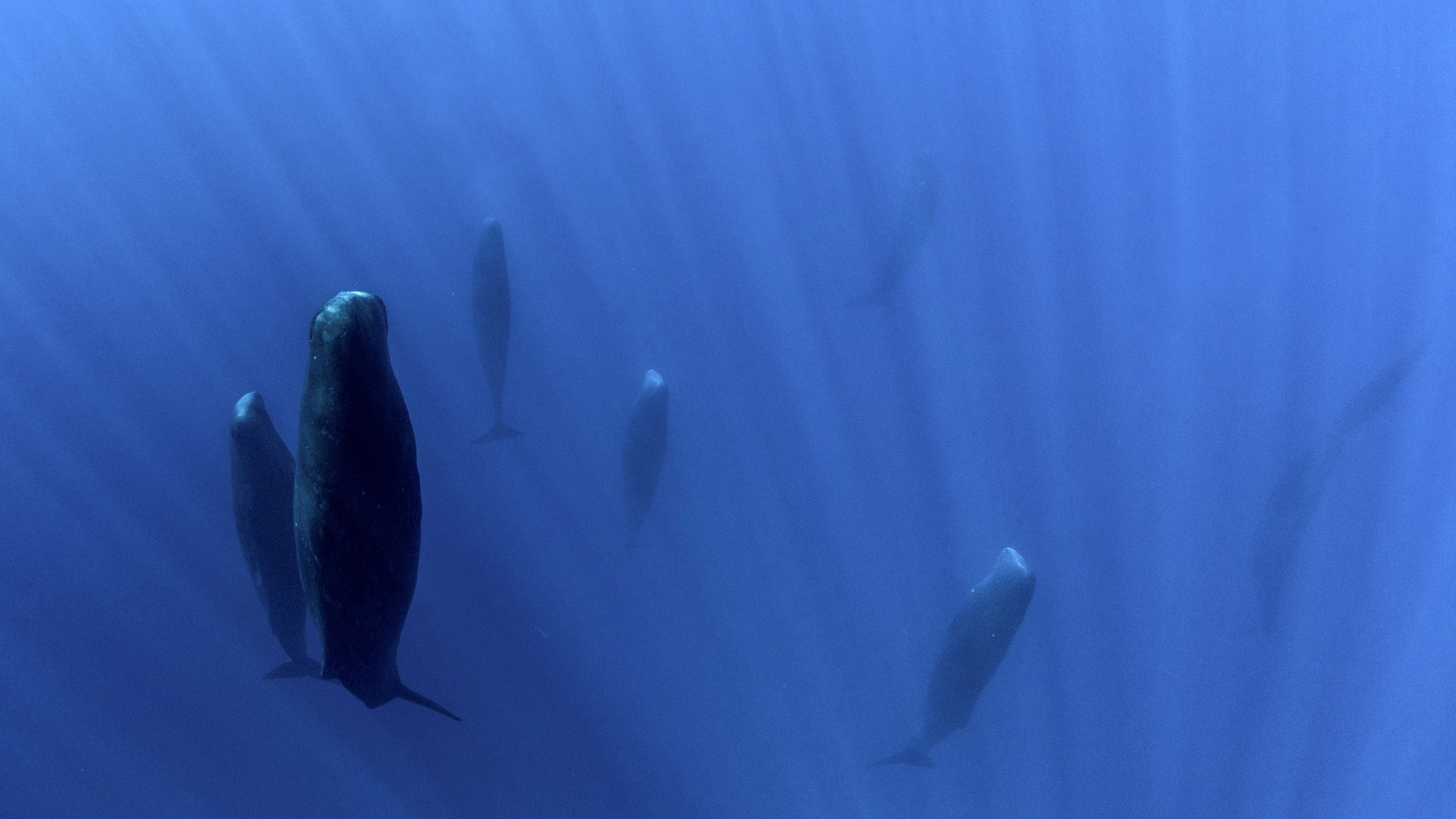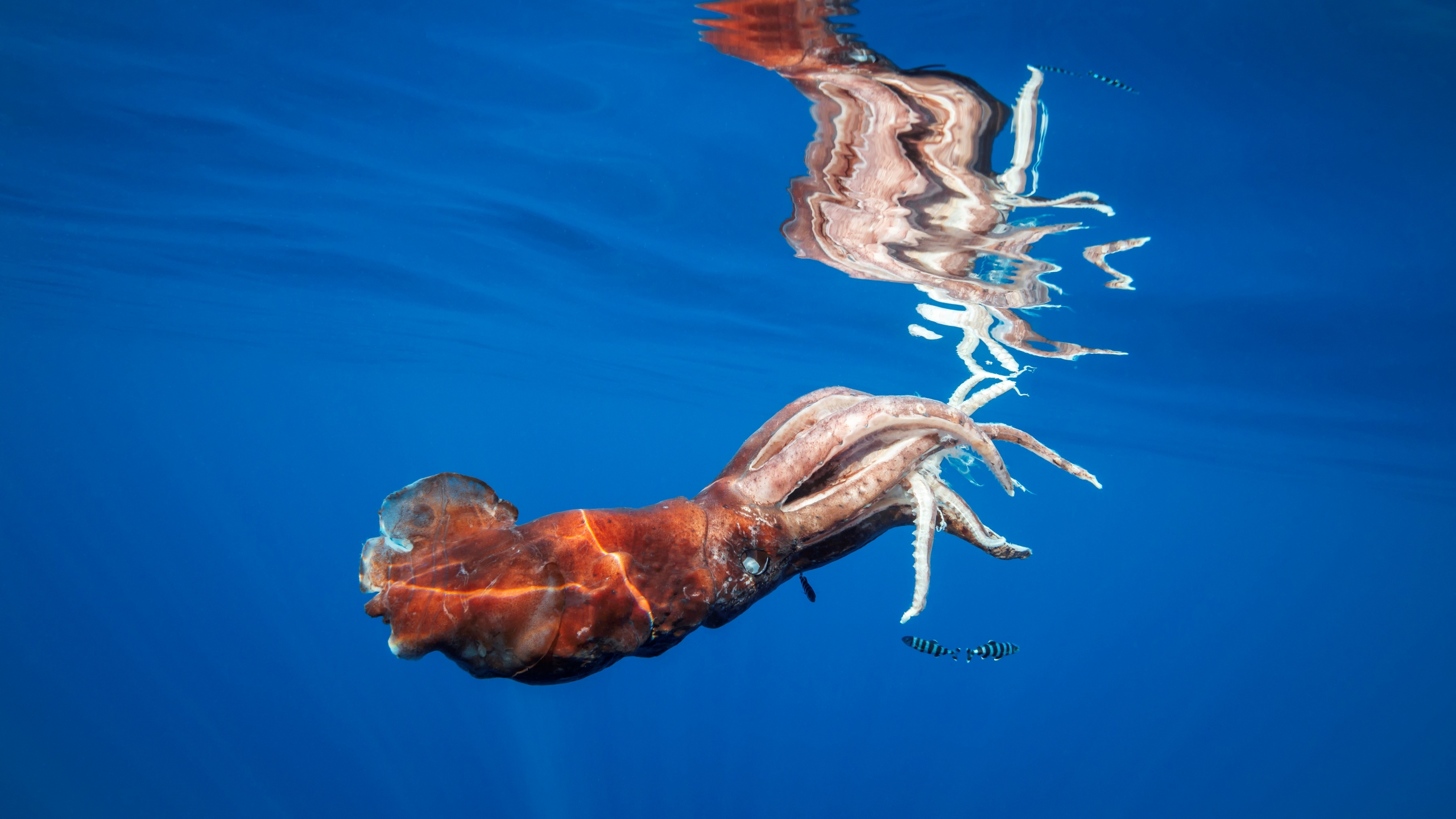Sperm whales: The biggest toothed predator
Sperm whales eat giant squid for breakfast.
Sperm whales (Physeter macrocephalus) are the largest toothed whales, with enormous square-shaped heads and the biggest brains of any animal on Earth. These deep-divers are known for hunting down giant squid and other prey as deep as 1.9 miles (3 kilometers) below the ocean surface.
Sperm whales are the only living species in the genus Physeter and are more closely related to dolphins than to baleen whales, such as blue whales. The name sperm whale comes from early whalers who mistook the waxy oil found in the spermaceti organ in a sperm whale's head for semen, according to the Zoological Society of London (ZSL).
Size: Up to 59 feet (18 meters) long
Life span: Potentially more than 70 years old
Conservation status: Vulnerable
Humans hunted sperm whales extensively in the 1800s and 1900s for their spermaceti oil to use in oil lamps and other products, according to the National Oceanic and Atmospheric Administration (NOAA).
Whale hunting is now banned in most countries, and the commercial trade has largely ceased. However, the sperm whale population has yet to recover from whaling and they remain vulnerable to extinction, according to the International Union for Conservation of Nature (IUCN).
Related: Sperm whales outwitted 19th-century whalers by sharing evasive tactics
How big is a sperm whale?
Male sperm whales can reach up to 59 feet (18 meters) long and weigh up to 62.8 tons (57 metric tons). Females are smaller and max out at 36 feet (11 m) long, and weigh up to 16.5 tons (15 metric tons), according to the wildlife charity Whale and Dolphin Conservation (WDC).
A sperm whale's head makes up about one-third of its entire body length. The whales have a distinctive, narrow lower jaw that contains all of their teeth. Sperm whale teeth are cone-shaped and can be up to 7.9 inches (20 centimeters) long and weigh 2.2 pounds (1 kilogram) each, according to the B.C. Cetacean Sightings Network, a research and conservation program in Canada.
Get the world’s most fascinating discoveries delivered straight to your inbox.
Related: Rare sperm whale fossils shed light on mysterious family tree
Where do sperm whales live?
Sperm whales live in oceans around the world, and their geographic range covers almost all marine waters that are deeper than about 3,280 feet (1,000 m) and not covered by ice, according to the IUCN.
Age, gender, food availability and other factors influence where sperm whales live and travel, but their migration is not as predictable or well understood as other whale species. Mature males may undertake long migrations into cooler waters toward the poles for better food sources, while females and their young stay in warmer, tropical waters all year round, according to NOAA.
Social life and breeding
Sperm whales are social animals and use a range of vocalizations to communicate with each other, including clicks and whistles. They often live in groups of about 30 individuals but group size varies and some individuals live solitary lives. The most common group types are nursery school groups, made up of mature females and their juvenile offspring; and bachelor groups, made up of sexually inactive males. Mature males usually live alone, according to the University of Michigan's Animal Diversity Web (ADW).
Kingdom: Animalia
Phylum: Chordata
Class: Mammalia
Order: Cetacea
Family: Physeteridae
Genus & species: Physeter macrocephalus
Source: ITIS
Migrating mature males typically return to tropical waters in spring to breed with females. After mating, females have a gestation period of 14 to 16 months before giving birth to a single calf. Calves drink their mother's milk for several years but also start eating solids, such as squid, in the first 12 months of their lives, according to the Norwegian Polar Institute.
Female sperm whales reach sexual maturity at 8 to 11 years old. Males may reach sexual maturity at about 10 years old, but they don't reach a high enough social position to mate until they are in their 20s, according to ADW. Scientists don't know the exact lifespan for sperm whales but evidence suggests the whales can live into their 70s, according to the Norwegian Polar Institute.
Sperm whales sleep for about 10 to 15 minutes at a time by diving down in the water, turning around, and napping in a vertical position with their tails down, while they slowly float back up towards the surface, Live Science previously reported. They only spend about 7% of their time in this inactive state, which is less time than any other mammal spends sleeping, according to a 2008 study published in the journal Current Biology, which was the first study to document this unusual sleeping behavior.
Related: Sperm whales speak in accents
What do sperm whales eat?
Sperm whales may dive as deep as 1.9 miles (3 kilometers) below the surface and hold their breath for two hours while looking for prey, according to WDC. They mostly eat squid, octopuses, sharks and other animals that live in the deep ocean, particularly giant squid. These massive invertebrates will put up a fight against the predatory whales and will leave scars on the whales after cutting them with the spiky, round suckers on their tentacles, according to the American Museum of Natural History.
Related: Beached sperm whale in Australia shows scars from tussle with a giant squid
Sperm whales don't usually pose a danger to humans, but there are some historical accounts and tales of the whales attacking whaling ships. The whale in Herman Melville's 1851 novel "Moby Dick" was named after an aggressive, real-life sperm whale called Mocha Dick, an albino male first seen near the Chilean island of Mocha in South America. The white whale allegedly attacked whaling ships and killed men, before whalers successfully hunted and killed him in 1838, according to BBC News.
Albinism is rare in nature but has been documented in many species, including whales. Individual white whales are occasionally spotted today. For example, an albino gray whale (Eschrichtius robustus) was filmed off the coast of Mexico in 2019, Live Science previously reported. There haven't been any recently recorded sightings of albino sperm whales, but they may exist.
Are sperm whales endangered?
The IUCN considers sperm whales to be vulnerable to extinction, but after a 2008 assessment, experts are unsure if the sperm whale population is increasing, decreasing or stable. Scientists roughly estimate that there were about 1.1 million individuals in 1700 and the population dropped by about 67% to 360,000 individuals by the 1990s, due to whaling. Large-scale, commercial whaling ceased in about 1980 but it's not clear whether sperm whale populations have since increased, or are still decreasing. Japan is currently the only country still hunting sperm whales, according to ZSL.
Sperm whales face other human-caused threats, such as entanglement in fishing gear, being struck by ships and pollution, according to the IUCN. The whales are included on the U.S. Endangered Species List and protected under the Marine Mammal Protection Act, according to NOAA.
Related: 220-lb. 'litter ball' found inside a dead sperm whale's belly
Additional resources
- Book: "The Great Sperm Whale: A Natural History of the Ocean's Most Magnificent and Mysterious Creature" (University Press of Kansas, 2011). Available to buy at Amazon.
- BBC Earth has a short video on YouTube about how sperm whales use sound.
- The Dominica Sperm Whale Project offers more information about sperm whale research.

Patrick Pester is the trending news writer at Live Science. His work has appeared on other science websites, such as BBC Science Focus and Scientific American. Patrick retrained as a journalist after spending his early career working in zoos and wildlife conservation. He was awarded the Master's Excellence Scholarship to study at Cardiff University where he completed a master's degree in international journalism. He also has a second master's degree in biodiversity, evolution and conservation in action from Middlesex University London. When he isn't writing news, Patrick investigates the sale of human remains.






